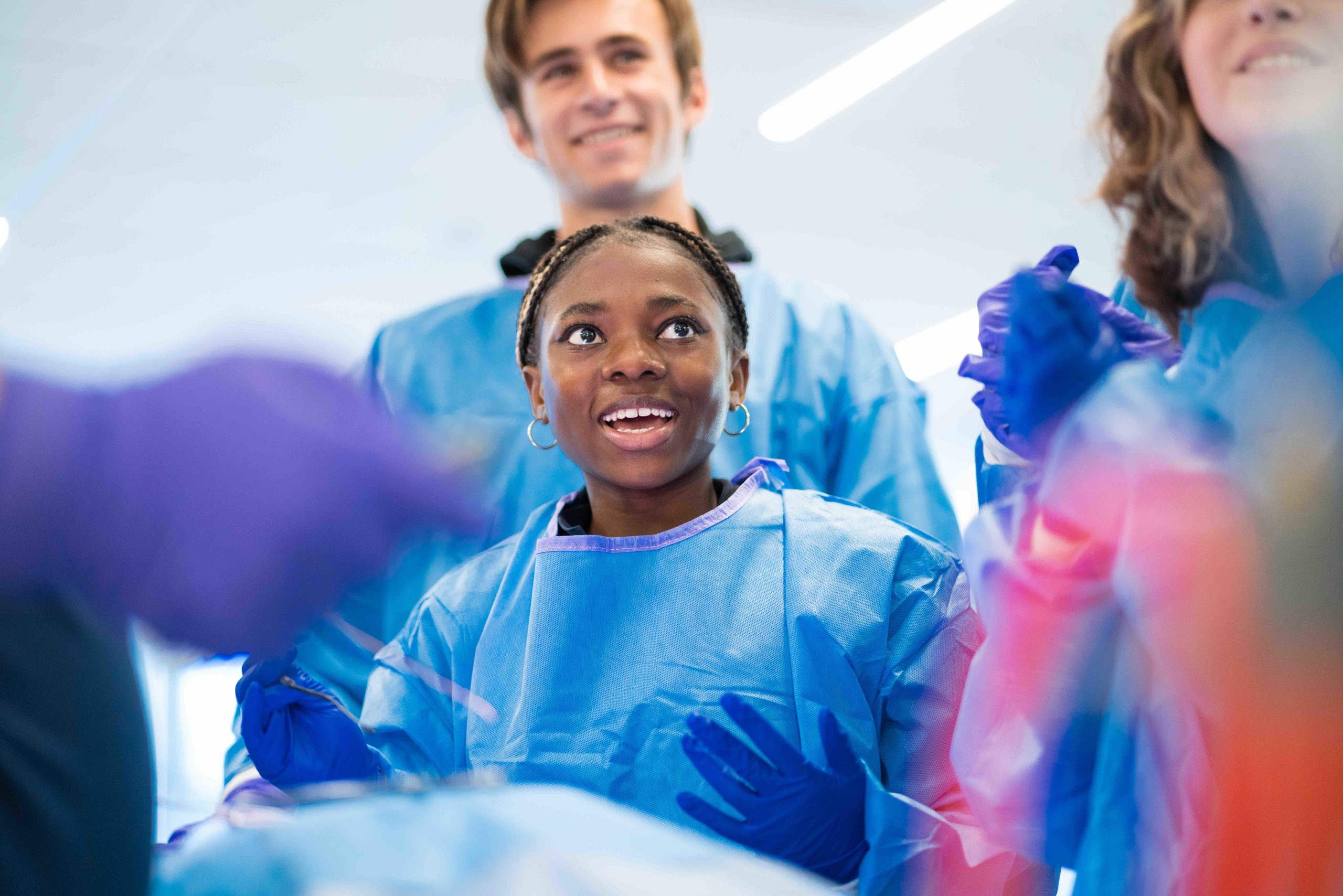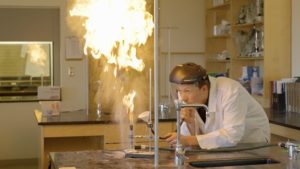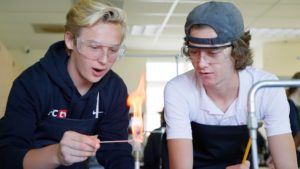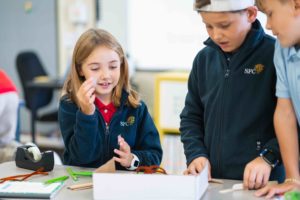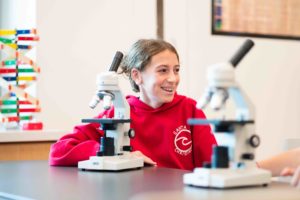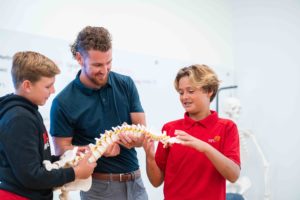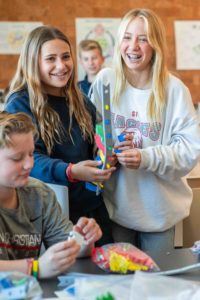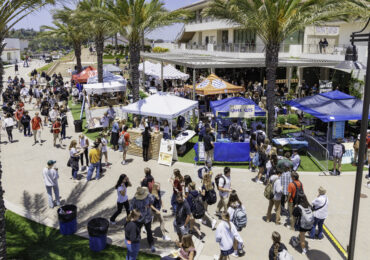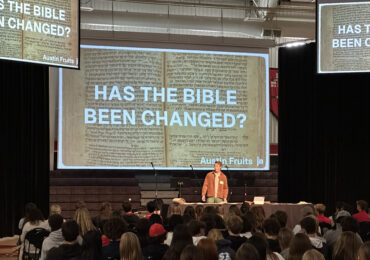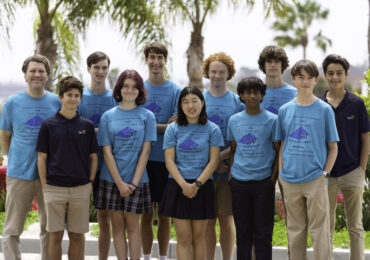To many people in our modern world, faith and reason seem at odds with one another. But are they truly incompatible? How can we go about teaching scientifically accurate curriculum to young people while integrating a Biblical perspective?
To consider answers to these questions and more, four science teachers from Santa Fe Christian share their thoughts. Brock Fellows and Megan Ziegler are passionate High School science teachers at SFC. Grantham Jones ignites the minds of middle schoolers in his Forensics and Biology classes, and Kelley Bickley teaches STEM (Science, Technology, Engineering, and Math) at SFC’s Elementary School.
They discuss cultivating an appreciation for science in their students, the intersection of science and faith, scientific methods of instruction, and equipping students with skills that will be used beyond the classroom.
The Educational Background of Science Teachers at SFC
Contrary to some narratives, many science teachers who are Christians have strong science backgrounds that rival their secular counterparts. Science teachers at SFC have impressive track records of scientific education and experience.
Ziegler shares that her love of biology and nature began when she was a little girl, and it blossomed when she decided to study Biology in college at Cal Poly. “I never saw a conflict between my faith and science,” she says, “but other people did. I think it’s one of the amazing ways I get to understand our Creator – by knowing His creation.”
Similarly, Fellows’ fascination with science started when he was very young. Inspired by his mother who is a nurse, he decided to obtain a degree in Biology from UCSD. After graduating, he worked in a research lab and thought about pursuing a career as a scientific researcher. But when he was offered a lab manager position at UC Riverside, he felt drawn to study the Bible, so he decided to go to seminary instead.
After earning a degree in Biblical Studies, Fellows began searching for a way to combine his love of science with his love of faith. He began teaching science classes including physics, chemistry, biology, and anatomy.
Now, as an AP Biology and Honors Chemistry teacher at SFC, he can teach students science with an understanding of the interrelation among each specialty. “I’ve seen most of the high school curriculum and have taught it in some way. When I’m teaching chemistry, I’m thinking about how many of these students will go on to take physics or chemistry – how can I best prepare them for that?”
Having received high-quality science education themselves, SFC science teachers are well-equipped to pass their deep scientific knowledge on to their students.
Methods of Instruction in SFC Science Classes
Science tends to be a difficult subject for some students to grasp. For this reason, it’s up to teachers to make the material interesting and comprehensible.
As Ziegler points out, “As teachers, we have such power to make our content either come alive, be interesting and relatable, or make it like a drudge. When I first started teaching, I was working with students who had absolutely no interest in science, and I quickly learned that to be an effective teacher, I was going to need to take the content and put it in a context that’s approachable and applicable to the people I was teaching.”
Learning Science in High School
So, how does a teacher go about sparking students’ interest in science? Ziegler says she utilizes plenty of project-based learning and something called “phenomena-based teaching” which involves connecting different concrete ideas to processes that naturally occur in the environment. In her words, it “gives the content somewhere to live. Because content without somewhere to live is just a bunch of facts, and that doesn’t really help us.”
To illustrate this type of learning, Ziegler references a sustainable development project she led for one of her classes. “Just down the street from the school, there’s a building project that’s been in the works for a while. So we visited the site, we did some soil testing, we did some noise pollution testing, we read all the documents from the City of Solana Beach and all the environmental science work that had gone into it, and we made sense of the environmental impact.”
With projects like this one, Ziegler can demonstrate how the scientific concepts her students learn in class translate into real-world problems and careers.
Learning Science in Lower and Middle School
Similarly, in Elementary School and Middle School, students get to take field trips and experience scientific concepts hands-on.
Elementary School science classes take trips to places like the lagoon and the zoo, or they may invite specialists from different fields to visit Santa Fe Christian and speak to students about certain topics. For example, Bickley recalls having invited a woman from a local floral company to give second graders a presentation on the topic of pollination.
In Middle School, field trips and projects are elective-based, and students can choose between a variety of science electives, including Marine Biology, Forensics, and Engineering.
So, students in the Marine Biology elective, for example, may take trips to the aquarium. “In Forensics,” Jones explains, “we start with things like glass fracturing or fingerprinting. Then, we do a fire forensics project where they see how different fabrics will burn, and we do chromatography tests with different inks. Ultimately, at the end of the quarter, they have a campus-wide crime that they have to solve by going around to different stations.”
These types of hands-on learning experiences engage students in the material they hear about in class and read about in books. In addition, because teachers embrace project-based learning all along the K-12 spectrum, students receive consistent instruction that helps them learn about increasingly difficult concepts.
The Progression of Science Education From Kindergarten to High School Graduation
As a K-12 private school, SFC has the unique opportunity to provide a cohesive educational experience across all grade levels. Operating under the NGSS (Next Generation Science Standards), teachers progressively build upon their students’ science skills.
For example, in their science classes, students dissect different specimens in each grade level. They start by dissecting pickles in kindergarten, which Bickley explains is to “learn the techniques of dissection. They’re so surprised there are seeds inside the pickle!” Then, by the time they reach high school, students get to perform the frog dissection.
Even the simplest science experiments point students toward deeper truths about the world around them and the One who created it. They demonstrate the “intricacies of God’s creation, and they learn that He created everything for a purpose,” Bickley says.
Jones is grateful for this K-12 structure because, by the time Middle School students reach his classroom, they’ve gone through five different iterations of this same process. Its progression in difficulty and complexity prepares students well for the AP Biology and Anatomy classes that await them in High School.
The Integration of Science and Faith
Some people believe that science and faith are, by definition, at odds with each other. But the science teachers at SFC have a different perspective.
Having been to seminary and a scientist, science teacher Brock Fellows has a unique perspective on the complementarity of faith and science. “I never saw an inherent conflict,” he says. “In the Psalms, we see a variety of psalmists marvel at what God has created, and that turns upward toward worship. And that’s not uncommon in the field of science.”
He points to a quote from Louis Pasteur, a scientist who helped develop many of our modern sanitation methods: “The more I study nature, the more I stand amazed at the work of the Creator.”
As he teaches his students about the natural world, Fellows explains that the reason the processes and organisms they observe appear to be designed is that they are.
Incorporating faith into science instruction doesn’t mean denying students exposure to alternative points of view, however. Fellows says that insulating students from perspectives different from their own tend to backfire, particularly during the later years of High School.
“Having students think through design, evolution, atheism, and the age of the earth – it cultivates in students an excitement to study and think through challenging topics without this worry that they’re going to be one of the many statistics of students who are Christians in high school and go on to abandon the faith.”
Ziegler doesn’t shy away from these discussions with her students, either. She wants to help her students understand the purpose of science and its limitations. She asks her students questions like, “What is God’s design for our understanding of science?” And “How does the practice of science point us toward God?”
Science classes at SFC are where students can form a deeper understanding of and confident biblical perspectives on the natural world.
What Real-World Skills Do Students Learn in Science Classes?
Regardless of whether or not students end up in science-related professions, science classes impart valuable skills that will benefit them throughout their lives. Most notably, they learn to think critically, work well with others, and persevere through difficulties.
Critical Thinking
One of the most useful skills SFC students adopt in their science classes is the ability to think critically about problems and their potential solutions.
Students learn to evaluate the credibility of sources, identify patterns and trends, and make predictions based on their observations. They also develop the ability to design and conduct experiments, which requires them to think critically about the variables that need to be controlled and the methods they should use to collect data.
Jones explains that the goal of science classes is not simply to gain science-related skills. “With STEM (Science, Technology, Engineering, and Math) at the forefront of where we’re at in the educational zeitgeist, we want to build up those basic skills,” he says. “But overarchingly, we want these kids to be able to critically think in whatever they do.”
As students get older, this skill develops. High School science classes teach students to think critically about the implications of scientific discoveries. Students learn to evaluate the potential impact of scientific research on society and the environment and to consider the ethical and moral implications of different scientific developments.
No matter what career path SFC students follow, critical thinking skills will help them become better problem solvers who are capable of considering the big picture.
Teamwork and Collaboration
Teamwork is another major emphasis within SFC’s science classrooms. Students have plenty of opportunities to collaborate on projects and learn about what it means to be a reliable team member.
Through group projects, lab work, and research, students learn to communicate effectively, share resources, and rely on each other’s strengths and abilities.
“When they go into the workforce later in life, we hope these kids can work well as a team,” Jones says. “In my class, there’s a ton of group work so they can work with their friends, have some time to learn about the content, and ultimately become good teammates.”
Team dynamics teach children how to communicate respectfully when they disagree with another person’s point of view, a skill the world most certainly needs. As students work together toward solutions, they also learn to be open to others’ ideas.
Resilience
Because subjects like chemistry, physics, biology, and anatomy are difficult to master, students learn to be flexible, creative thinkers and risk-takers within an intellectually safe classroom environment. This translates into the real world as students go on to experience life’s ups and downs.
“I want to create an environment where it’s ok to struggle,” Fellows says. “I think more and more the culture is averse to struggle and working through things. I think that doesn’t serve us well in the long run.”
SFC science teachers present meaningful opportunities for students to encounter obstacles and failures, whether in the form of an experiment not working as planned or a challenging concept to grasp. But through these challenges, students learn to adapt, try different approaches, and grow in resilience.
Overall, science classes provide students with the necessary skills and mindset to face setbacks with determination and bounce back from failure. Santa Fe Christian’s science teachers equip students to explore and understand the world around them, so they can gain knowledge, develop skills, form intelligent perspectives, and appreciate the beautiful design of their Creator.
